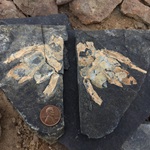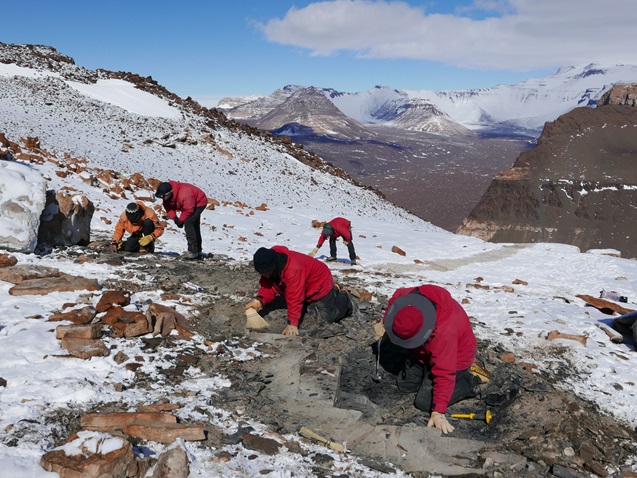Vertebrate Paleontology
About the Collection


Vertebrate paleontology in the United States originated in Philadelphia through the efforts of physicians and natural historians associated with the American Philosophical Society and The Academy of Natural Sciences. Native Philadelphian, Dr. Joseph Leidy (1823-1891) was a particularly brilliant anatomist working at the Academy during the growth of paleontology as a scientific discipline. Many call Leidy the father of vertebrate paleontology in this country. Edward Drinker Cope, another Philadelphian, made tremendous contributions to vertebrate paleontology from his home base at the Academy. After a hiatus of almost a century, research in vertebrate paleontology is active again at the Academy of Natural Sciences.
The historical core of the Academy's collection includes the Thomas Jefferson Fossil Collection, the first dinosaur fossils from North America, the only fossil collected by Lewis and Clark, as well as the extensive collections of Leidy and some of the Cope collections. Although many of these specimens have great historical value, they also remain crucial for primary research. Today, the vertebrate fossil collection houses more than 22,000 specimens and that number is rapidly growing through recent research efforts. Recent and ongoing collections projects have included renovation of the fossil preparation lab and some of the collection space as well as upgrading the conservation of all specimens.
Click here for a list of current staff in the vertebrate biology department.
Current Research


Current paleontological research at the Academy of Natural Sciences is focused on Late Devonian-age fossils (375 to 365-million-years-old) from the Catskill Formation in northern Pennsylvania and from the Okse Bay Group in the Nunavut Territory of the Canadian Arctic. This work has already uncovered thousands of new fossils that dramatically illustrate the diversity of life and the evolving ecosystems during this critical interval in earth history. Fossils uncovered in this project are also providing important data on the origin of limbed animals (tetrapods) from fishy precursors. Research from the Catskill Project is presented at the Devonian Times web site.
Loan Policy

Loans of specimens are made at the discretion of the curator-in-charge to institutions under the name of a permanent staff member of the institution. Specimens must not be moved to another address without written permission from Academy of Natural Sciences. A loan request from a student must be countersigned by their major professor who will assume responsibility for the specimens.
No more than one-half of the total specimens of a species will ordinarily be lent at a time. The remainder may be requested after return of the first loan. Series of specimens from single localities may be borrowed as units so long as they do not exceed one-half of the total. Fragile specimens (e.g., certain skeletal and larval materials) will ordinarily not be lent. Non-type specimens are loaned for a period of one year. Holotypes and paratypes are loaned separately from other specimens. Type material is loaned for a period up to 6 months.
The recipients of loans must agree to the conditions for handling and use of the specimens stated in the Loan Agreement below.
Loan Agreement

Recent research on conservation problems in our collections has shown that many specimens are more delicate than we had previously assumed. Therefore, we have instated the conditions below for handling and use that must be agreed upon in order to receive material on loan from the Vertebrate Zoology Department of the ANSP.
- Gentle compressed air may be used to clean a specimen. No other cleaning may be attempted without written permission.
- No repairs may be made to specimen(s) unless written permission is obtained. Please do not use any kind or glue or other adhesives.
- No coatings (including sublimated ammonium chloride or magnesium oxide, or SEM coatings), stains, consolidants, molding media, separators, etc., may be applied without written permission.
- No sampling or destructive analyses of any kind are to be performed on specimens without written permission.
- Competent specimens may be measured and photographed. Please minimize exposure of specimens to hot photofloods.
- All efforts must be made to store specimens under stable conditions that would minimize exposure to dust, and fluctuations in temperature and relative humidity.
- All contents of each specimen should be returned, including all labels, contained sediments, etc. Original data labels many not be written on under any circumstances. Any systematic change contemplated, especially type designations, or comments regarding a particular specimen, should be annotated with the specimen upon its return, on a separate slip of paper. Please include the ANSP catalogue number, the name of the person annotating the specimen(s), and the date the annotation was written.
- It would be greatly appreciated that relevant reprints regarding any of the loan specimens be sent to the Vertebrate Zoology Department when they become available.
- Specimens must be unpacked and repacked with care, preferably using the same material(s) with which they were received. Please be aware that specimens are easily broken by over packing and by insufficient cushioning.
- The loan must be returned by the time stipulated, unless a loan extension has been granted.